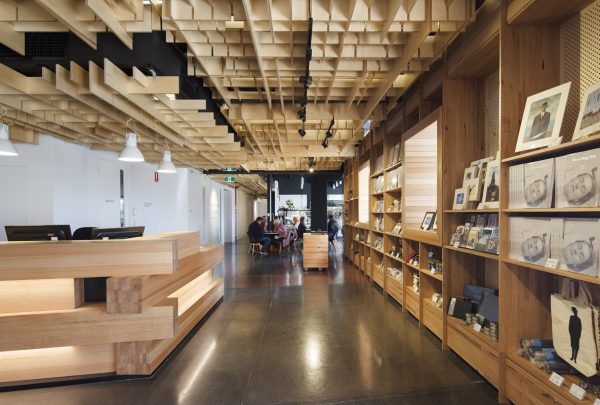CLT (Cross-Laminated Timber) is when layers of timber cut from a single log are glued together symmetrically, with the grain of each outer layer alternated at 90-degree angles. The most common method is to use an odd number of layers that are glued together in the same orientation.
This process was first developed in Austria and Germany in the 1990s. Gerhard Schickhofer, an Austrian researcher, greatly contributed to the research into cross-laminated timber. CLT experienced a boom in usage throughout the whole of Europe by the early 2000s and hasn’t slowed down since.
Cross-laminated timber is not the best choice for exterior applications, especially when used as external cladding material. This is because CLT is not designed to be exposed or used in exterior environments due to being sensitive to moisture. This is why cross-laminated timber must be protected from sources of moisture such as rain.
As a popular choice when it comes to engineered wood products, glulam (Glue-Laminated Timber) is when laminates are bonded and glued together. This process is done by layering each laminate with the grain, which results in producing larger and longer length members.
Glulam also has a long and rich history. It is widely accepted that glulam was first used all the way back in 1842 in the Holy Trinity church in England. In fact, the King Edward VI College had glulam roof structures constructed in 1866 which are still standing today.
However, internal stresses in the wood would lead to detachment issues over time that plagued many construction projects. To address this issue, resin glue was invented in 1928. It provided an affordable and waterproof alternative with a high adhesive strength that was also much easier to use.
There are many grades and species of glue-laminated timber which are widely used for both interior and exterior applications. For outdoor applications, GLT timber systems such as MASSLAM are most commonly used for outdoor structural purposes including roofing, beams and external columns.
Glulam is used in a wide variety of applications due to its versatile, superior strength and durability qualities such as:
The key difference between both is their strength properties.
Because cross-laminated timber is made by alternating each layer at 90-degrees, its strength goes in two directions. The direction that has the highest number of layers is the strongest point, whereas the weakest point relates to the direction with the least amount of layers.
The difference with glulam is that is it constructed with all of its layers oriented towards the same direction. This means all its strength goes in one direction, making it ideal for support structures such as trusses, columns and beams.
The laminating process for GLT makes it perfect for applications requiring heavier loads, complex shapes and longer spans than reinforced steel and concrete. In terms of strength, Glulam timber is one-sixth the weight of concrete and one-tenth the weight of steel, and is stronger than steel due to its greater stiffness and strength.
However, when it comes to a majority of mass timber projects, CLT and glulam are both used during construction in order to take full advantage of their benefits.

There are many benefits of using CLT for construction. These can include:
There are even more benefits to using glulam, which include:
CLT and glulam can go hand in hand. Glulam beams with a post ‘grid’ offer many open plan design options for applications such as offices and commercial buildings. In these scenarios, laminated hardwood beams and posts are used as supporting grids that incorporate CLT or glulam floor members.
So, which is better? Well, the advantage of using glulam over CLT is that the open plan of a grid system allows partition walls to be constructed and/or removed when required. Best of all, glulam is cheaper to construct because it has less volume than timber. The ‘honeycomb’ CLT systems are commonly used as load-bearing walls and are fixed in position to create a closed-plan design.
Now don’t get us wrong, CLT and glulam are both sustainable, strong and viable options for mass timber construction. However, glulam allows the flexibility of different shapes and the ability to change a space, whereas CLT offers a static system.
But when it comes to knowing which one is best suited to your project, it will largely depend on the design and building structure.

The mass timber construction industry is on the rise in Australia and we are seeing more architects and engineers embrace mass timber options. Existing buildings include:
With many industry professionals opting for mass timber, it will be exciting to watch the development of this inspiring industry.
ASH has an entire glulam product range called MASSLAM which caters to mass glue-laminated beams. We have also serviced many projects including the RMIT Garden Building and the Latrobe Regional Gallery. MASSLAM column and beams are sustainable, strong, affordable and fire-resistant – ideal for your next project.
Find out how we can help your next project get off the ground by contacting us below.
